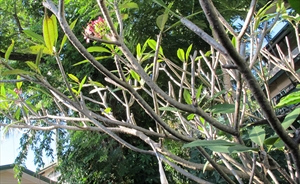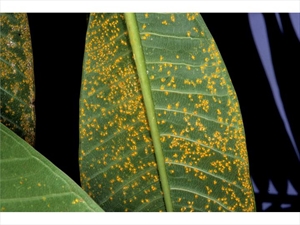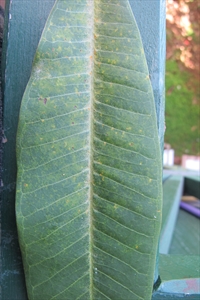Frangipani rust
Pacific Pests, Pathogens, Weeds & Pesticides - Online edition
Pacific Pests, Pathogens, Weeds & Pesticides
Frangipani rust (243)
Coleosporium plumeriae
Asia, North America, Oceania. It is recorded from Australia, American Samoa, Cook Islands, Federated States of Micronesia, Fiji, French Polynesia, Guam, Marshall Islands, New Caledonia, Samoa, Solomon Islands, Tokelau, Vanuatu, and Wallis & Futuna.
Frangipani (Plumeria species). It also occurs on the pink or Madagascan periwinkle, Catharanthus roseus.
A serious disease causing unsightly spotting and defoliation (Photo 1). Small numerous yellow-orange spots (called 'uredinia' pustules) occur on the underside of leaves which burst to liberate masses of spores (Photos 1-3). A tell-tale sign is to rub a finger across the leaf. If the rust is present, the powdery spores will turn the finger reddish-brown, the colour of rust - hence the name of the disease. The top of the leaf develops greenish marks (Photo 4) and, later, brown patches. and fruits are infected. No alternate hosts are known.
The spores are spread in the wind, but need humid conditions and leaf surface wetness to germinate and infect.
Infected leaves fall earlier than those that are healthy, and this may set back the growth of young plants, although larger trees appear to grow normally. The disease is unsightly, but will not kill the tree. In severe cases, especially under shady humid conditions, defoliation occurs.
Look for the yellowish-orange spots on the underside of the leaves. Rub a finger across the leaf (see under Symptoms & Life Cycle) to see if the spores turn the finger a rust colour.
CULTURAL CONTROL
- Take cuttings for planting only from disease-free plants; if that is not possible, take leafless cuttings, plant them in pots in a nursery, and spray them with fungicide.
- Collect infected and fallen leaves, and burn them. Irrespective of doing this, infections may occur from air-borne spores.
RESISTANT VARIETES
Some varieties are more tolerant to infection than others. Get advice from nurseries, or look at the different varieties near you. The variety with white flowers appears more susceptible.
CHEMICAL CONTROL
It is not economic to spray large plants in gardens with fungicides, but fungicides may be necessary in nurseries to prevent defoliation and also spread of the rust on plants for sale. If fungicides are needed use:
- Protectant products such as chlorothalonil, mancozeb and sulfur, or those containing copper. Apply before infections are seen.
- Systemic products, such as oxycarboxin (Plantvax) or triadimefon. These are suitable for use if infections are already present as they are systemic products.
____________________
When using a pesticide, always wear protective clothing and follow the instructions on the product label, such as dosage, timing of application, and pre-harvest interval. Recommendations will vary with the crop and system of cultivation. Expert advice on the most appropriate pesticide to use should always be sought from local agricultural authorities.
AUTHOR Grahame Jackson & Eric McKenzie
Information from (including Photo 4) McKenzie E (2013) Coleosporium plumeriae: PaDIL -(http://www.padil.gov.au); and from Coleosporium plumeriae. BugwoodWiki. (https://wiki.bugwood.org/Coleosporium_plumeriae).
Produced with support from the Australian Centre for International Agricultural Research under project PC/2010/090: Strengthening integrated crop management research in the Pacific Islands in support of sustainable intensification of high-value crop production, implemented by the University of Queensland and the Secretariat of the Pacific Community.








